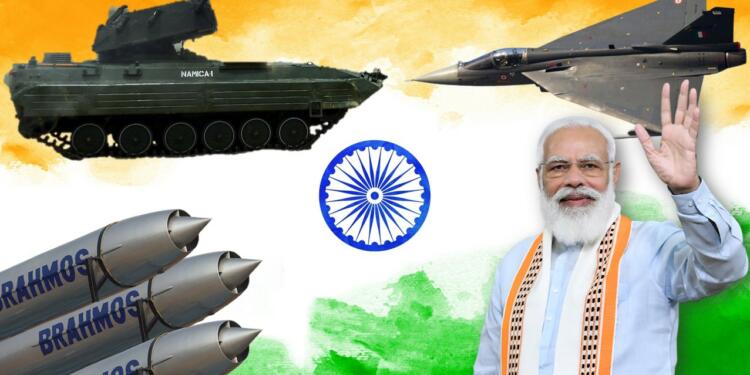- The value of arms exports by India has grown approximately by six times since 2014, with the ongoing financial year registering Rs 11,607 crore till now from Rs 1,941 crore in FY15.
- The Indian government has set an ambitious annual export target of around Rs 36,500 crore by 2025.
- Modi government is slowly changing the structure of the defence industry. From giving space to more large private companies such as Tata and Adani to pushing for reforms in Ordnance Factory Board, and now a focus on defence technology startups.
In the last few years, India has strengthened its defence manufacturing ecosystem. And now the country has not only started manufacturing for domestic use but also exports. The value of arms exports by India has grown approximately by six times since 2014, with the ongoing financial year registering Rs 11,607 crore till now from Rs 1,941 crore in FY15.
“During this period, many reforms/steps have been taken up by the government to boost defence exports and enhance ease of doing business,” said junior defence minister Ajay Bhatt.
The Indian government has set an ambitious annual export target of around Rs 36,500 crore by 2025. Bhatt said that the corporatisation of the Ordnance Factory Board (OFB) and its 41 factories into seven PSUs will also help in boosting exports.
Also Read: Make in India initiative not just strengthened the defence sector, but also killed corruption
For decades, India has been one of the largest users of foreign military equipment given enemies on the Western and Eastern borders. However, despite such large uses of military equipment, the country has not been able to build an indigenous defence manufacturing industry, because the sector has been dominated by public sector units. And, just like all other sectors that were dominated by PSUs, there was very little innovation in the Indian defence industry.
While the American defence industry gave rise to Silicon Valley (most of the modern information technology tools, from chips to the internet, trace their origins to funding by American armed forces), the Indian defence industry continued to be a liability on the public exchequer.
But the Modi government is slowly changing the structure of the defence industry. From giving space to more large private companies such as Tata and Adani to pushing for reforms in Ordnance Factory Board (it has been split into various PSUs and will compete with private players to get contracts rather than having a monopoly on certain items), and now a focus on defence technology startups.
Read More: Defence startups could be the new buzzword, the budget clearly points at that
In the first term, the Modi government brought the Make in India initiative to promote domestic manufacturing in various sectors including defence. Although the sector did not get a boost on expected lines, at least many big business houses entered the sector. In the second term, the Modi government is not only promoting the manufacturing of state art technological weapons for the Indian Armed Forces but also for exports.
$50,000/- will be allotted to promote the export of defence equipment manufactured in India. Defence attaches (a military expert who is attached to a diplomatic mission) across the world have been asked to submit a detailed action plan to promote Indian military exports in their respective countries. The countries are categorized as A, B, C according to the prospect for exports and the attaches will get money as per this categorization.
The defence ministry started iDEX (innovation for defence excellence) has set up incubators (incubators provide basic infrastructure for startups to operate) and is allocating crores of rupees to these incubators to fund startups. 14 incubators have been established under the iDEX scheme, and crores of rupees are flowing to defence startups through them.
Moreover, the defence ministry has big plans to purchase equipment from the startups. The Finance Minister, in the budget FY 23, announced that 68 % of the capital expenditure for defence startups will go to Indian companies. In the last few years, the government’s procurement of defence-related goods and services from micro and small enterprises (MSEs) climbed marginally by 2.2 per cent to Rs 9,293 crore in FY21 from Rs 9,090 crore in FY20, after declining from Rs 12,112 crore in FY19. And as these startups come up with better products, the purchase will go up.
Also Read: Aatmanirbhar Bharat and Make in India schemes are all set to make India a global defence powerhouse
So far, almost all of the Research and Development (R&D) funds went to PSUs and other departments under the defence ministry. However, the finance ministry announced that from this year onwards, 25 per cent of R&D will go to industry, startups, and academia, thus widening the pool of money available to private players.
The Modi government identified 12 military platforms and weapons systems for production in India to achieve the aim of “self-reliance”. They are fighter aircraft, medium lift and utility helicopters, warships, land combat vehicles, missile systems, gun systems, small arms, ammunition and explosives, surveillance systems, electronic warfare (EW) systems and night fighting enablers, among others. They said the policy aims to make India one of the top five manufacturers of defence platforms with the active participation of public and private sectors






























